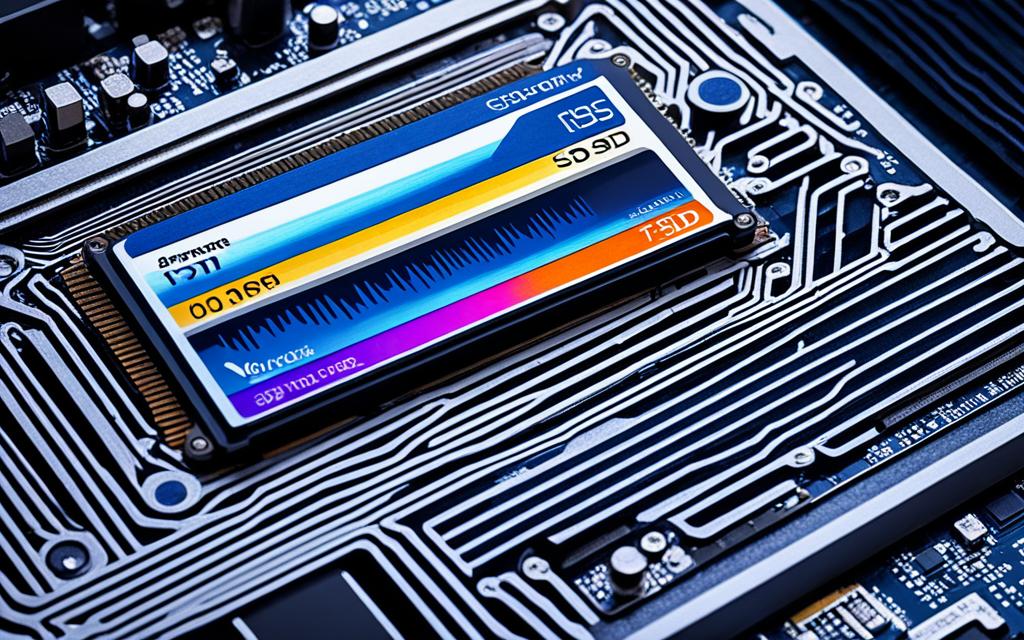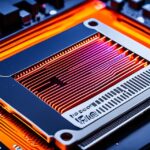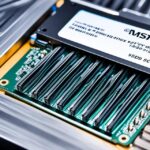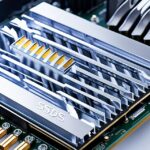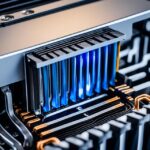Table of Contents
In today’s fast digital world, NVMe SSDs are critical for improving computer performance due to fast data speeds. Yet, they face a problem. They get hot when they work. This raises an important question: do NVMe SSDs really need heatsinks? We will look into what NVMe SSDs are, why they get hot, and how we can keep them cool. By understanding how to cool SSDs, you can make sure they work well and last long. This helps your computer tasks run more smoothly. For more depth, check out the expert analysis provided here1.
Key Takeaways
- NVMe SSDs work best between 0°C and 70°C, so keeping them cool is important.
- Heatsinks become crucial for PCIe 4.0 and PCIe 5.0 NVMe SSDs when there’s a lot of data to handle. This stops them from slowing down.
- Most new motherboards have at least one M.2 cooler, which helps with SSD cooling.
- Getting too hot can harm data and shorten the life of SSD performance optimisation.
- It’s important to consider the specific cooling needs of different NVMe SSD brands for the best heat management.
Understanding NVMe SSDs and Their Components
NVMe SSDs mark a big leap in storing data, thanks to their cutting-edge architecture and key NVMe SSD components. These components work together, leading to quicker data transfer. This reduces wait times and improves how well different software run.
The Core Components of NVMe SSDs
An NVMe SSD’s performance comes down to a few critical parts. These include the controller chip, the DRAM chip, and the NAND flash memory. The controller chip acts like a brain, managing data and issuing commands. It helps data move smoothly, which boosts speed.
The DRAM chip acts as quick storage, speeding up how fast data can be fetched. Meanwhile, the NAND flash memory keeps data safe even without power. It’s vital for both the speed and trustworthiness of the drive. When these parts work in unison, NVMe SSDs can meet the needs of intense computer tasks.
However, this efficiency leads to the generation of heat. That’s why it’s important to manage the temperature to keep performance levels high. For those dealing with lots of data, like in gaming or analytics, understanding these components is crucial. To learn more about how NVMe SSDs work, check this detailed guide on SSD technology2.
Why Do NVMe SSDs Generate Heat?
NVMe SSDs get very hot mainly because they can process a lot of data fast. When they handle big tasks or run programs that use a lot of data like video editing or gaming, they can get hotter than 80°C. That’s much hotter than the usual 30°C to 65°C they should be at3. The parts inside, like the controller and DRAM chips, start working hard and get hot depending on the job.
After being used, SSDs can keep some of that heat, which might slow them down even when they’re not doing anything. It’s very important to keep an eye on how hot your SSD gets. If it gets too hot, it could work poorly, lose data, or even get damaged4. A lot of new motherboards have built-in ways to cool them down. This helps keep the M.2 SSD from getting too hot1.
If you’re doing a lot of demanding work on your computer, it might be good to get extra cooling, like a heatsink. This helps keep your SSD from getting too hot and makes sure it runs well.
Does NVMe SSD Need Heatsink?
The need for an NVMe SSD heatsink depends on how hot the drive gets. Most NVMe SSDs work well between 30°C to 65°C. But they can go over 80°C with heavy use3. High heat for too long can slow the SSD down to prevent damage. This can cause slow loading and even lost data3.
Temperature Ranges and Performance
Staying within the right temperature helps keep performance up. If an NVMe SSD gets hotter than 65°C, it might slow down4. Some drives, like the Samsung 980 Pro, can work fine without extra cooling. Yet, for gaming and tough tasks, a heatsink helps keep speeds up and prevents crashes3.
Factors Affecting Heat Production
Different things affect how hot an NVMe SSD gets. These include system airflow, drive workload, and SSD design. Most new motherboards have an M.2 cooler. But these might not always cool the SSD enough3. If the SSD is often above 65°C, adding a heatsink or improving airflow is key for keeping it cool and working well4.
| SSD Model | Heatsink Recommendation | Key Features |
|---|---|---|
| Crucial T700 | Integrated Premium Thermal Heatsink | Maximises performance without noise |
| Samsung 980 Pro | Optional Heatsink | Works fine without, but recommended for high-stress tasks |
| Sabrent M.2 2280 SSD Rocket Heatsink | Aftermarket Heatsink | Efficient heat dissipation for gaming |
| Jonsbo M.2-3 SSD Cooler | Aftermarket Heatsink | Optimised for high-performance applications |
In summary, a heatsink for an NVMe SSD improves temperature control. It also lessens the chance of the SSD slowing down due to heat34.
The Importance of Cooling for NVMe SSDs
It’s vital to keep NVMe SSDs cool for the best performance and long life. The right cooling solutions make a big difference, especially when under heavy use. There are two main types: passive and active cooling.
Cooling Mechanisms Explained
Passive cooling uses heatsinks on SSDs to get rid of heat without moving parts. This method keeps the SSD working well, which is important because NVMe SSDs are much faster than Serial ATA drives5. For example, the ATP 8 mm heatsink has a lot of surface area to dissipate heat. Plus, it’s made of lightweight aluminium, which conducts heat well5.
Active cooling, however, uses fans or liquid cooling to directly cool the SSD. Many motherboards have built-in M.2 coolers, but sometimes you might need more3. Adding a heatsink helps keep the temperature in the safe range of 30°C – 65°C. This is crucial because NVMe SSDs can get hotter than 80°C3.
More than 70% of M.2 NVMe SSD users worry about overheating6. For those doing heavy work like video editing, 45% face heat problems with their drives6. Knowing about these cooling methods helps fix heat problems. This improves SSD performance and reliability.
| Cooling Type | Features | Recommended Usage |
|---|---|---|
| Passive Cooling | Heatsinks for SSDs, no moving parts | Recommended for all M.2 NVMe SSDs |
| Active Cooling | Fans, liquid cooling systems | Ideal for high-performance workloads |
| Combined Solutions | Heatsinks with fans | For optimal performance in demanding scenarios |
Choosing the right SSD cooling options keeps your drive running well. It also makes it last longer.
When Is a Heatsink Necessary for Your NVMe SSD?
A heatsink is crucial for certain SSD usage scenarios, especially under heavy use. This includes transferring big files or using demanding apps. These actions can cause NVMe SSDs to heat up quickly, sometimes going over 80°C3. Normally, SSDs work well between 30°C to 65°C3. But too much heat can slow down your device, risk losing your data, and shorten its life3.
If you work with lots of data, think about using a heatsink with your NVMe SSD. Video editors, for instance, really benefit from a heatsink’s cooling effect. However, if you only move data now and then, you might not need it. Most new motherboards, like 2nd Gen Ryzen, have a built-in cooler for M.2 slots3. But these coolers often aren’t big enough to keep things cool3.
Not all NVMe SSDs need a heatsink for their best performance, especially Gen 3 SSDs. But Gen 4 and newer ones might need one to avoid getting too hot during heavy use7. A good heatsink can keep your SSD cool and ensure it runs smoothly7. Brands like Micro Connectors, Sabrent, Jonsbo, and Cryorig FROSTBIT offer affordable cooling solutions3.
Deciding on a heatsink depends on how you use your computer. If you often do tasks that push your system hard, a heatsink can help keep everything running well.
Signs Your SSD Might Be Overheating
Spotting SSD overheating signs is key to keeping your NVMe SSD working well. You might notice fans running more than usual or software that doesn’t respond. High heat in an M.2 NVMe SSD can slow it down and make it less reliable. This can cause performance issues and affect your system.
Performance Throttling Indicators
When SSDs get too hot, they may lower their speed to cool down. This is called thermal throttling. It happens if the SSD’s temperature goes beyond 70 degrees Celsius. A Gen4x4 SSD without a proper heat sink8 can get this hot in just 40 seconds. SSDs work best between 0°C and 70°C. Going over this range could mean your SSD is getting too hot9.
High-speed SSDs can heat up quickly. For instance, a Gen3x4 SSD can reach 70 degrees Celsius in just three minutes. This makes managing heat very important8. SSDs under a lot of strain or with poor cooling can heat up fast. This might cause performance issues like system slowdowns or crashes9.
Keep an eye on your SSD’s temperature often. It shouldn’t go above 80 degrees Celsius. That could harm your data8. Using a good cooling system can lower overheating risks. It helps keep your SSD in good shape for longer.
Conclusion
It’s vital to know how to keep NVMe SSDs cool to make them work better and last longer. Not every NVMe SSD needs a heatsink. But, whether you need one depends on how and where you use it. NVMe drives are much faster than old SATA drives. They can reach speeds up to 7000 MB/s. This makes them great for tough tasks1011.
In small systems with little air flow, NVMe SSDs can get too hot. This can cause data problems and harm the drive. Heat management is key, especially in fanless servers and data loggers. These need to work reliably at certain temperatures10. NVMe drives work best between 35 to 70 degrees Celsius. Keeping them in this range helps avoid slow-downs11.
Buying a heatsink might be a smart move if you often process lots of data quickly. Good cooling keeps NVMe SSDs running fast and smoothly, even when it’s hot. Plus, NVMe drives are getting cheaper. Now is a good time to improve your system’s speed1011.
FAQ
Do NVMe SSDs really require heatsinks for optimal performance?
Whether you need a heatsink for your NVMe SSD depends on how much you use it. If you’re into heavy tasks like video editing or gaming, a heatsink helps stop overheating and keeps things running smoothly. For everyday use, you might not need one.
What are the key components of an NVMe SSD?
An NVMe SSD has key parts like the controller chip, DRAM chip, and NAND flash memory chips. The controller manages data, the DRAM speeds up access, and the NAND flash holds your data. These parts work together to make the SSD fast.
Why do NVMe SSDs generate heat?
NVMe SSDs heat up mainly when processing lots of data. This can happen during multitasking, big file transfers, or using data-heavy apps. The busier they are, the hotter the controller and DRAM chips get, causing the SSD to heat up.
What temperature range is critical for NVMe SSD performance?
NVMe SSDs work best between 0°C and 70°C. Performance may drop if it gets hotter than 65°C to avoid damage. It’s important to keep an eye on these temperatures to make sure your SSD performs well.
What cooling mechanisms are available for NVMe SSDs?
You can cool your NVMe SSD with passive methods like heatsinks or active ones like fans or liquid cooling. Heatsinks are great for absorbing heat without any moving parts. Some motherboards also come with their own cooling solutions.
When should I consider adding a heatsink to my NVMe SSD?
Consider a heatsink if your SSD works hard often, like with many big file transfers or heavy apps. A heatsink can prevent it from getting too hot and slowing down.
What are the signs that my NVMe SSD might be overheating?
Overheating signs include a noisy fan, slow performance, or freezing software. Using software to watch your SSD’s temperature can alert you to any issues. This lets you act before it gets too hot.
Source Links
- https://www.corsair.com/us/en/explorer/diy-builder/storage/is-cooling-necessary-for-an-m2-nvme-ssd/ – Do you need to cool your M.2 NVMe SSD?
- https://blog.westerndigital.com/ssd-heatsink-hot-storage-cool-data-m2/ – SSD Heatsink: Hot Data, Cool Storage
- https://www.easeus.com/computer-instruction/do-i-need-a-heatsink-for-my-m2-ssd.html – Do I Need a Heatsink for My M.2 SSD [2024 Full Guide]
- https://www.crucial.com/articles/about-ssd/do-you-need-an-nvme-ssd-heatsink – Do you need an NVMe SSD heatsink?
- https://www.atpinc.com/tw/about/stories/overcoming-nvme-thermal-throttling-temperature – NVMe SSD Thermal Management: What We Have Learned from Marathons
- https://pedagogue.app/the-importance-of-heatsinks-for-m-2-nvme-ssds/ – The Importance of Heatsinks for M.2 NVMe SSDs – Pedagogue
- https://www.cgdirector.com/does-m-2-ssd-need-heatsink/ – Does Your M.2 (NVMe) SSD Need a Heatsink?
- https://www.techtarget.com/searchstorage/post/Understand-SSD-overheating-and-what-to-do-about-it – Understand SSD overheating and what to do about it | TechTarget
- https://www.easeus.com/computer-instruction/can-ssd-overheat.html – SSD Overheating? Check Full Explanation and Reasons!
- https://www.atpinc.com/tw/blog/is-heatsink-needed-for-nvme-ssd – How to Sustain Performance for NVMe Drives Under Thermal Stress Conditions
- https://www.sbpcmechanic.com/nvme-ssds-the-need-for-heatsinks-and-optimal-temperature-range/ – NVMe SSDs: The Need for Heatsinks and Optimal Temperature Range – Santa Barbara Computer Repair “PC Mechanic” | Data Recovery

